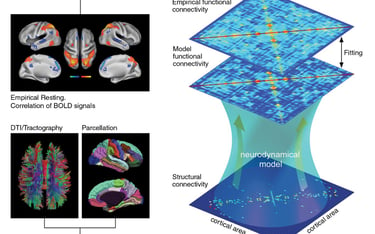Large-scale brain models
In the past years, we have developed a theoretical framework that combines analyses of neuroimaging data and large-scale models to understand the emergence of correlations, or functional connectivity (FC), in whole-brain networks during both resting-state and task conditions. In the 2000s decade, the question of how FC emerges from the brain’s structural architecture motivated several studies to understand the relationship between brain structure and function, and its potential breakdown in disease. However, the mechanistic origin of resting-state and a general, close relation between structure and function was lacking.
Using stochastic dynamical systems in combination with empirical data we have elucidated general principles of local circuits and whole-brain dynamics. The formalism gives a mathematical relation between the network connectivity, the neural dynamics, and the FC (Deco et al. 2013 J neurosci; Ponce-Alvarez et al. 2013 PNAS), and provides a mechanistic explanation for the building up of state-dependent effective FC under resting-state (Deco et al. 2013, 2014, J neurosci; Gilson et al. 2016 PLoS CB), task conditions (Ponce-Alvarez et al. 2015b PLoS CB), stroke (Saenger et al. 2018 Cereb Cortex), neuromodulation (Pfeffer et al. 2021 Science Advances), and different brain states — e.g. sleep (Jobst et al. 2017 Sci Rep) and low-level states of consciousness (López-González et al. 2021 Nat Comm Biol). Furthermore, it explains the emergence of stimulus-dependent second-order statistics and their impact on population codes — a phenomenon that we observed in spiking neuronal data and that we explained using attractor networks and information theory (Ponce-Alvarez et al. 2013 PNAS). Moreover, our studies show that time-varying FC can result from transient exploration of metastable states (Ponce-Alvarez et al. 2015a PLoS CB). Information-theoretic analysis demonstrates the functional benefits of state-dependence and metastability. In a recent review, we deepened the idea of neuronal communication through transient dynamics (Hahn et al. 2019 Nat Rev Neurosci) and showed how it can be used to gate information. More recently, I have examined the effect of delayed interactions on correlations and spectral properties of whole-brain models (Ponce-Alvarez and Deco 2024 Sci Rep).
These models were included in The Virtual Brain, an open-source simulation platform performing whole-brain simulations using biological connectivity data to test both scientific and clinical questions. In the long run, the goal of The Virtual Brain is to provide personalized medicine for the brain, by offering therapeutic solutions that are specific for each patient.


Linking anatomical connections and functional connectivity. Neuroanatomical connectivity data is obtained by diffusion imaging and tractography. Parcellation provides a structural connectivity matrix C linking N brain regions with clear anatomical landmarks. A neurodynamical model is then built using a set of stochastic differential equations (SDEs) coupled according to the connectivity matrix C. The model spatiotemporal patterns are compared to the ones observed in empirical data (e.g., fMRI, MEG). The SDEs can be analytically solved to obtain a link between anatomical structure, resting-state dynamics, and eventual external inputs.